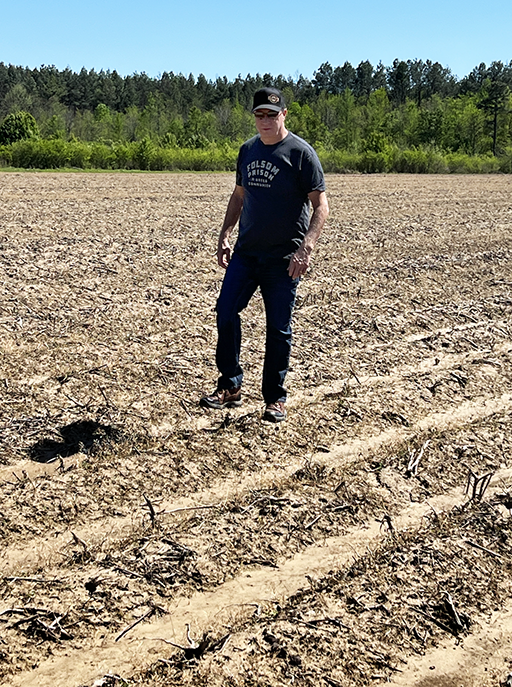“Plants sure know the difference between rainwater and hose water.” That was my wife’s observation Saturday morning, after seeing the rapid overnight growth, beautiful green color, and new blooms from our garden plants, following a thunderstorm that brought a half-inch of rain. My wife was right, of course (granted, after 30 years of marriage admitting my wife is right comes second nature, but this time she’s scientifically right). A big advantage of rainwater is nitrogen, which can be two-fold. Rain carries nitrates from the atmosphere that has a greening and growth-inhibiting effect on the plants. But in the event of a thunderstorm, lightning can deliver additional nitrogen to crops, accounting for about 10-15 pounds per year. Lightening is the inspiration for the famous Haber-Bosch process, which converts atmospheric nitrogen into ammonia. HBP is credited for feeding over half of the world’s population, by making nitrogen cost effectively available to farmers.
Farming is a very geo-centric business. Where you farm affects how you farm. Take a trip across rural America and you’ll see how farmers apply methods adapted to their unique landscape, resources, and challenges. Terraces cascade across the rolling hills of western Iowa to manage soil erosion. On the Great Plains, no-till is used to preserve moisture and soil. In Ohio, where precipitation is plentiful, soybeans are grown in narrow rows. And in the Mississippi Delta – where we have a high-water table and receive 55 inches of annual rainfall – we commonly utilize the practice of furrow irrigation. Unlike overhead or pivot irrigation systems, where water rains down from above the crop via specialized equipment, furrow irrigation is a low-tech method that sends water below the crop. This requires a unique seedbed preparation practice called hipping. After the soil is disked, small hills are formed using tillage equipment that “hip” up the soil, creating furrows in between the hills. The tops of hills are then shaved off to create a level seedbed and seeds are planted on the hills of the rows. When the crops need a drink, poly pipe is rolled across the headlands, water is pumped into the pipe, and holes are punched in the pipe to allow water to drain down the furrows, where it can be absorbed by the plants. In addition to providing a low-cost method of irrigation, the hipped hills also help protect the crop from getting wet feet from heavy rains. So, the practice helps growers manage the Delta’s abundance of water in multiple ways.

Working for Huma and operating a farm is like being a kid in a candy story. That’s why I’m excited for #Plant24 and having access to so many MCT-powered products. I’ll plant Wednesday or Thursday, depending on how much rain we end up with today. I’ll utilize furrow irrigation and plant 2” deep on 38-inch rows. All crop inputs, other than the AgriGold 6659 seed corn and Syngenta Acuron herbicide, will be 100% Huma. I’ll be planting thick, a population of 48,000 seeds per acre, and feeding the plants early, late, and often. I’ll be providing weekly progress reports. My goal is to top 300 bushels per acre with a nitrogen use efficiency of 0.50. No offense to Andy Williams, but now is the most wonderful time of the year.
Sunday is Cinco de Mayo. Many Americans will celebrate by eating delicious Mexican food. But American farmers celebrate the other 364 days of the year from the food Mexico buys from us. Our friends from the south are the second largest agricultural export market, to the tune of over $28 billion annually. Mexico is our largest corn customer, accounting for 47% of all our exports, and is on pace to set a record at over 15 million metric tons. Our southern neighbor is also the top destination for US dairy, wheat, poultry, distillers grains and rice. Since NAFTA was signed in the 1990s, US trade with Mexico has quadrupled. Of course, trade goes both ways. The US is Mexico’s top ag export market by far, accounting for $47 billion. At Huma, Mexico is one of the largest markets for our humic-based fertility and crop protection products. For which we say to our Mexican friends, “¡Salud!”
Related Posts

Fertilgold® Organics Earns OMRI-Listing for 24 Initial Products
Fertilgold® Organics, a brand of organic fertilizer products from Bio Huma Netics, Inc. (BHN) headquartered in Gilbert, Ariz., has achieved Organic Materials Review Institute (OMRI) listing for 24 initial products. Of these, 18 OMRI-listed liquid crop nutrition products are based on the company’s proprietary nutrient carrier, Micro Carbon Technology®, which carries nutrients to plants more

Corn Records Without Rewards
Corn Records Without Rewards U.S. corn growers are smashing records in acreage and yield, but instead of golden returns, many are facing low prices and soaring input costs. Record bushels don’t always mean record profits.

BHN’s Lyndon Smith to Speak at New AG International Africa Conference
Bio Huma Netics, Inc., President and CEO Lyndon Smith has been selected to speak at the New AG International—Africa Conference, to be held April 6–8 in Marrakesh, Morocco. The full conference title is “A 360-Vision of Specialty Fertilizer, Precision Ag, Irrigation, and Biostimulant Developments in Africa.” Mr. Smith’s presentation, titled “The biostimulant effect of humic

